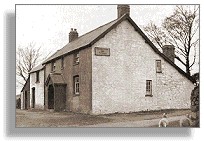The cross-country tracks
used by the drovers followed the shortest route possible, often over very
wild upland country. Even with the building of the earliest proper roads
long after they first began to cross Wales with their animals, the drovers
still kept to  their
own trackways.
their
own trackways.
When turnpike roads were built it became an expensive
business to move large numbers of animals through tollgates, but the 'roads'
over the hills were free. And these tracks caused less wear on the feet
of the livestock than the hard roads of the later years.
As the drovers could be on the move for weeks, they needed places to stop
along the way for food and rest for
the men and shoeing, grazing and watering for the animals.
but at least it's free !
 inns at intervals along the regular routes to meet the needs of the droving
trade. Some were simply part of a farm which provided rooms, food, and
ale or cider. There were also drovers' inns,
often in very remote locations, which had special enclosures for the different
animals, and a blacksmiths forge. The head drovers would sleep overnight
in the inns but the younger helpers would stay out to guard the livestock.
inns at intervals along the regular routes to meet the needs of the droving
trade. Some were simply part of a farm which provided rooms, food, and
ale or cider. There were also drovers' inns,
often in very remote locations, which had special enclosures for the different
animals, and a blacksmiths forge. The head drovers would sleep overnight
in the inns but the younger helpers would stay out to guard the livestock.